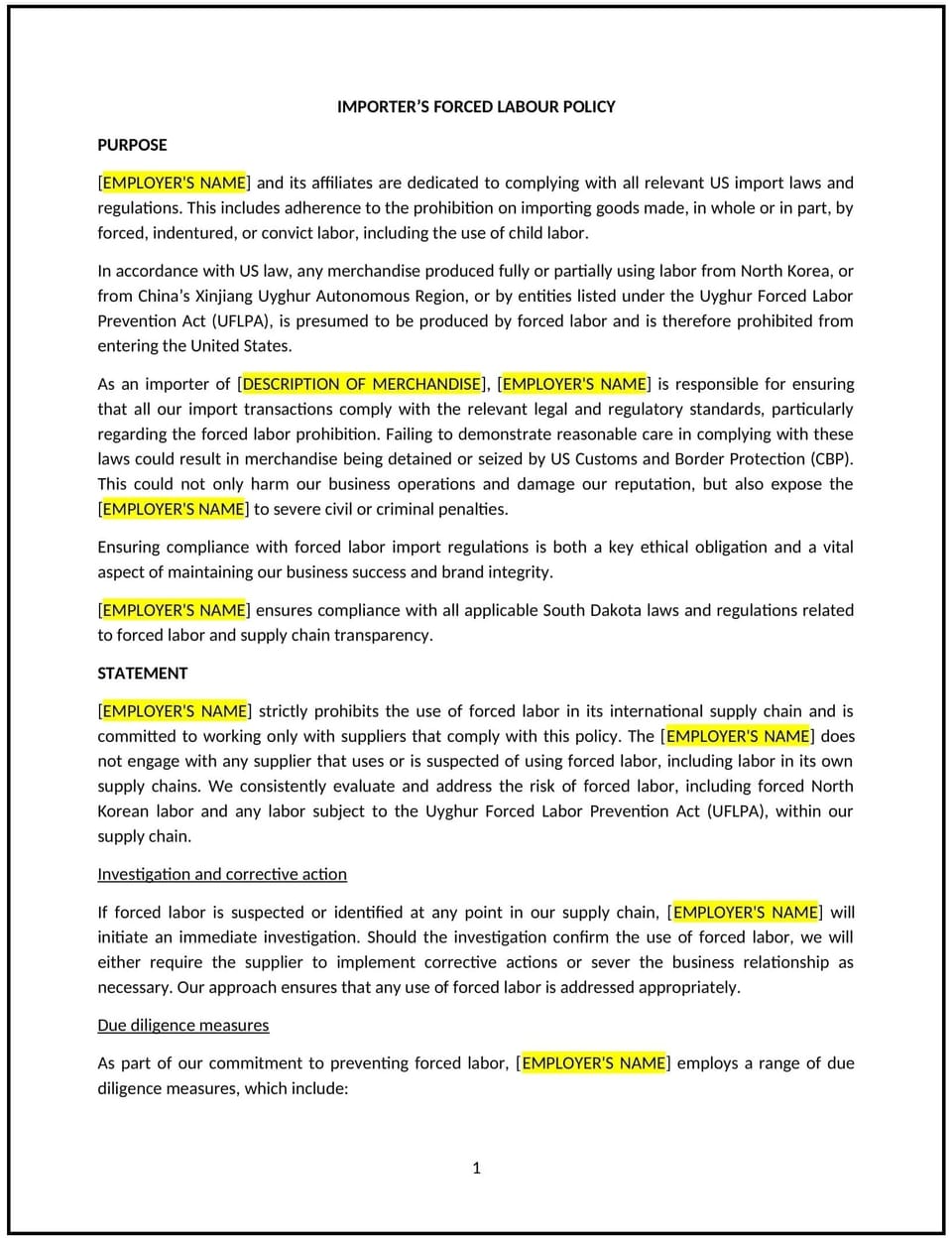Importer’s forced labour policy (South Dakota): Free template

Importer’s forced labour policy (South Dakota)
This importer’s forced labour policy is designed to help South Dakota businesses ensure their supply chains are free from forced labour and human trafficking. It outlines procedures for due diligence, supplier audits, and compliance with anti-forced labour laws.
By adopting this policy, businesses can promote ethical sourcing, reduce legal risks, and align with general best practices for supply chain transparency.
How to use this importer’s forced labour policy (South Dakota)
- Define forced labour: Explain what constitutes forced labour, including human trafficking and exploitative practices.
- Establish due diligence procedures: Specify steps for assessing suppliers and identifying risks of forced labour.
- Conduct supplier audits: Outline processes for auditing suppliers to ensure compliance with anti-forced labour standards.
- Address non-compliance: Provide steps for addressing violations, such as terminating supplier contracts or reporting incidents.
- Train employees: Educate staff on identifying and reporting signs of forced labour in the supply chain.
- Monitor compliance: Regularly review supply chain practices to ensure adherence to the policy.
- Review and update: Assess the policy annually to ensure it aligns with evolving regulations and ethical standards.
Benefits of using this importer’s forced labour policy (South Dakota)
This policy offers several advantages for South Dakota businesses:
- Promotes ethical sourcing: Demonstrates a commitment to preventing forced labour and human trafficking in supply chains.
- Reduces legal risks: Helps businesses comply with anti-forced labour laws and avoid penalties.
- Enhances reputation: Positions the business as a responsible and ethical importer.
- Builds trust: Strengthens relationships with customers, investors, and stakeholders by prioritizing ethical practices.
- Supports compliance: Ensures adherence to international and domestic anti-forced labour regulations.
Tips for using this importer’s forced labour policy (South Dakota)
- Communicate the policy: Share the policy with suppliers and include it in procurement agreements.
- Provide training: Educate employees on identifying and addressing forced labour risks.
- Monitor compliance: Regularly review supply chain practices to ensure adherence to the policy.
- Address issues promptly: Take corrective action if forced labour is identified in the supply chain.
- Update regularly: Assess the policy annually to ensure it aligns with evolving regulations and ethical standards.
Q: How does this policy benefit businesses?
A: By preventing forced labour, businesses can promote ethical sourcing, reduce legal risks, and enhance their reputation.
Q: What are signs of forced labour in supply chains?
A: Signs include restricted movement, withheld wages, excessive overtime, and poor working conditions.
Q: How should businesses handle non-compliant suppliers?
A: Businesses should address violations promptly, which may include terminating contracts or reporting incidents to authorities.
Q: Can businesses audit suppliers remotely?
A: Yes, remote audits can be conducted, but on-site visits may be necessary for high-risk suppliers.
Q: How often should businesses review this policy?
A: Businesses should review the policy annually or as needed to ensure it aligns with evolving regulations.
This article contains general legal information and does not contain legal advice. Cobrief is not a law firm or a substitute for an attorney or law firm. The law is complex and changes often. For legal advice, please ask a lawyer.


